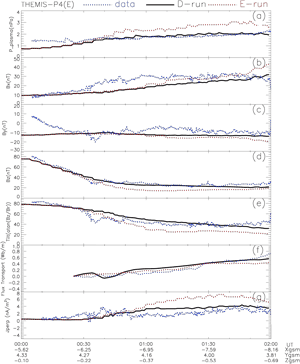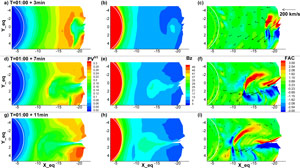
2012 THEMIS SCIENCE NUGGETS
RCM-E simulation of the 13 March 2009 steady magnetospheric convection event
by Jian Yang, Rice University
Introduction
The "pressure-balance inconsistency" or "pressure-balance crisis" states that the plasma pressure in the near-Earth plasma sheet would be considerably larger compared with empirical models if the plasma from the outer magnetotail is transported earthward adiabatically. One manifestation of the crisis is that the magnetic field stretches significantly in order to equilibrate earthward moving plasma. A natural resolution for the crisis are the time-dependent processes (i.e., substorms), because the stretched magnetic field will eventually make conditions favorable for plasma instabilities related to substorm onset. However, during steady magnetospheric convection (SMC) events, the magnetosphere exhibits enhanced convection that could last for several hours during fairly steady solar wind driving from a southward IMF BZ, but without substorms.
In this study, we investigate how the pressure-balance crisis is avoided during the 2009-03-13 SMC event, with a series of numerical simulations using the Rice Convection Model-Equilibrium (RCM-E) by applying different spatial and temporal distributions of depleted flux tubes on the outer boundary. Our results suggest that the crisis is unlikely to occur during SMCs if the flux tubes are depleted over a wide local time in the tail.
Figure 1. From top to bottom are (a) plasma pressure, (b)-(d) magnetic field (in GSM), (e) inclination angle (defined as in degrees), (f) flux transport and (g) current densities perpendicular to the local magnetic field at THEMIS-P4(E). The RCM-E simulated results are shown in black for the D-run and in red for the E-run, respectively. The observations are shown in blue. in degrees), (f) flux transport and (g) current densities perpendicular to the local magnetic field at THEMIS-P4(E). The RCM-E simulated results are shown in black for the D-run and in red for the E-run, respectively. The observations are shown in blue. |
Results
Figure 1 compares two RCM-E simulations with THEMIS-P4(E) observations. The simulation with THEMIS P2-C data applied to the entire nightside boundary of the RCM-E (called “D-run”) produces very good agreement with multipoint observations, including the magnetic field, plasma moments, estimated flux transport and the cross-tail current densities at THEMIS spacecraft in the near-Earth region. However, the simulation with empirical model boundary conditions (called “E-run”) predicts an over-stretched magnetic field and larger plasma pressure than observations. In the D-run, the inner magnetosphere is fed with lower flux tube entropy PV5/3 for most of the SMC interval than the E-run.
In order to investigate the effects of transient activities during SMCs, we applied appropriate plasma boundary conditions in the RCM-E simulation by assuming they are plasma-sheet bubbles with lower entropy than their neighbors, and follow their drift motions in self-consistent electric and magnetic fields. Figure 2 shows the sequence of the bubble injection in the background of the D-run. It demonstrates that the transient bubbles tend to cause relatively small magnetic field dipolarization and produce small-magnitude flows.
| Figure 2. Snapshots at different times during an idealized bubble injection in the D-run. From left to right are entropy parameter PV5/3 (in units of nPa(RE/nT) 5/3), BZ (in units of nT) and field-aligned current densities (color contours, in units of μA/m2, positives are down to the ionosphere) mapped on the equatorial plane. Black arrows in the right column are averaged drift velocities for protons. The white circles represent geosynchronous orbit. The Sun is to the left. |
Conclusion
The results are summarized as follows:
- RCM-E simulations with different spatially depleted boundary conditions indicate that, at least for this event, the pressure-balance inconsistency is effectively alleviated during a strong earthward convection interval only when the entire plasma sheet earthward of 20 RE is supplied with low entropy plasma.
- Additional RCM-E simulations show that the earthward transport of plasma-sheet bubbles in the background of the D-run, which mimics the overall configuration best, tends to cause smaller magnetic field dipolarizations and produce weaker flows than bubble injections in the background of the E-run. The results are consistent with the fact that, although there are transient flow bursts during SMCs, none of them are accompanied with significant large-scale reconfigurations in the near-Earth plasma sheet.
References
Biographical Note
Jian Yang is a research scientist in the Physics and Astronomy Department at Rice University. His current research interest includes numerical simulation and data analysis of plasma transport from the plasma sheet to the inner magnetosphere.
 Please send comments/suggestions to
Emmanuel Masongsong / emasongsong @ igpp.ucla.edu
Please send comments/suggestions to
Emmanuel Masongsong / emasongsong @ igpp.ucla.edu

